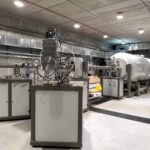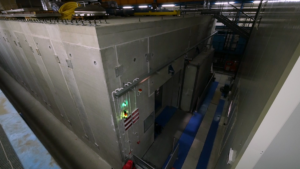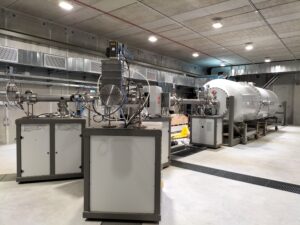
Underground Ion Beam Facility close to inauguration at Laboratori Nazionali del Gran Sasso – Italy

Entrance of the accelerator room for the 3.5 MV Singletron®. The walls are made of 80 cm thick concrete. During accelerator operation the sliding concrete door must be closed. It has been shown that outside the building the accelerator induced neutron flux is at least a factor of two lower than the natural neutron background inside the underground laboratories, which in turn is three orders of magnitude lower than the cosmic neutron flux at earth surface.
Since 1992, accelerators are used at the Gran Sasso National Laboratories (LNGS) of the Italian Institute for Nuclear Physics (INFN) to study the Big Bang, the centre of the Sun and stars in general. First, the home-built 50 kV accelerator LUNA-50 was installed. The pioneering experiment carried out with this machine by the LUNA collaboration (Laboratory for Underground Nuclear Astrophysics) allowed to study for the first time the cross section of the fusion reaction 3He+3He at solar conditions. This measurement, which due its extremely low reaction rate of less than one event per day would not have been possible in any aboveground laboratory, provided a key contribution to establish Neutrino Oscillation as solution of the so called “Solar Neutrino problem”. In view of this the Bethe Price 2010 has been awarded to Claus E. Rolfs, co-found of the LUNA-Collaboration, “For seminal contributions to the experimental determination of nuclear cross-sections in stars, including the first direct measurement of the key 3He fusion reaction at solar conditions.”
While LUNA-50 was decommissioned in 2001, LUNA-400, a commercial 400 kV Singltron® accelerator, was put to service in 2000. One of the first results obtained using this machine was the measurement of the 14N(p,γ)15O reaction, the bottleneck of the CNO cycle. Its rate was found to be a factor of two slower than expected. This result had several consequences, such as increasing the age of globular clusters by about 1 Gy and reducing the CNO solar neutrinos by a factor of two. Recently, a cross-section determination of the most important reaction affecting the primordial abundance of deuterium during Big Bang Nucleosynthesis (BBN) (i.e., D(p,γ) H) carried at LUNA-400 has been published in Nature and settled the previously most uncertain nuclear physics input to BBN calculations.
The National Laboratories of Gran Sasso, with financial support from the Italian Ministry of Research (Progetto Premiale “LUNAMV”), are currently expanding their accelerator park by installing a new 3.5 MV Singletron® machine from High Voltage Engineering Europe. The machine has already proven to provide intense proton, helium, and carbon beams (1, 0.5, and 0.15 mA, respectively) with well-defined energy resolution and stability for precision nuclear astrophysics measurement. It is currently in the final phase of commissioning in a dedicated laboratory built in the Hall B of LNGS.
In a second step, the LUNA-400 Singletron® machine will be overhauled and moved to the immediate vicinity of the 3.5 MV Singletron®.

The 3.5 MV Singltron® located inside the shielded accelerator room. The machine is equipped with two beamlines. The machine will be part of the LNGS IBF, which will be operated as a scientific user facility.
The complementary 400 kV and 3.5 MV accelerators will be the heart of the new LNGS Ion Beam Facility (IBF). The IBF will open new frontiers in nuclear astrophysics, nuclear physics research and applied sciences. A proposal for a first set of measurements has been presented by the LUNA Collaboration. It includes the reactions14N(p,γ)15O, related to stellar evolution and nucleosynthesis, and specifically the “metallicity” of the solar core; 12C+12C, affecting crucially the final fate of intermediate-mass and massive stars and the associated nucleosynthesis and 13C(α,n)16O and 22Ne(α,n)25Mg, which provide the source of neutrons in stellar interiors (the latter being in the context of the ERC Starting Grant SHADES).
In the course of the next years, the LNGS IBF will be developed into a scientific user facility for nuclear astrophysics, nuclear physics research and applied sciences. In view of this an Accelerator Service and a Program Advisory Committee (PAC) have been established recently.
While the landscape of deep-underground accelerator laboratories has grown in recent years, with the Compact Accelerator System for Performing Astrophysical Research (CASPAR) at the SURF (USA), and Jinping Underground Nuclear Astrophysics (JUNA) at the China Jinping Underground Laboratory providing first results, in particular new 3.5 MV Singletron® at LNGS does stand out with its energy range and intense carbon beam.
The LNGS Ion Beam Facility will allow LNGS to maintain its leadership in the field of underground nuclear astrophysics gained by the work of the LUNA Collaboration. It will also provide unique possibilities in the area of applied sciences, for example, environment or material science.



